

In
1955
the
Post
war
import
restrictions
had
been
lifted
by
the
British
Government,
this
meant
that
Jukeboxes
were
now
available
to
be
imported
onto
the
UK
far
cheaper
than
Ditchburn
could
build
them
at
the
Lytham
factory,
around
1954
Ditchburn
had
been
looking
at
the
German
Manufacturer
called
Tonomat,
they
were
producing
a
100
selection
Jukebox
that
was
well
engineered
and
with
slight
modifications
could
be
re-
branded
as
a
Ditchburn
Music
Maker
for
the
UK
market.
Arthur
Phillips,
Ditchburn’s
Chief
Audio
Engineer
told
us
that
between
1955
and
1956
they
imported
around
50
of
these
100
selection
units
from
Tonomat,
this
was
the
start
of
a
partnership
with
the
German
manufacturer
that
would last 5 years.
Here is Arthur’s story on the Tonomat Machines
The Tonomat Jukeboxes from Germany
Imported between 1955 and 1960
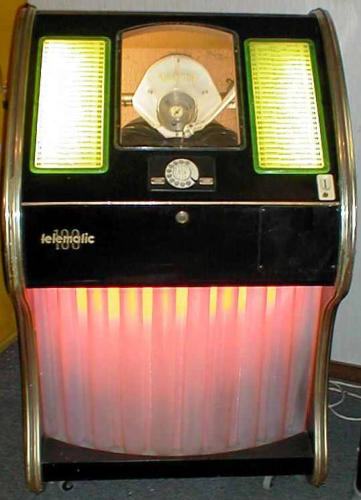
I
will
start
with
what
came
first
in
history,
in
1955
we
started
to
take
the
tail
end
of
the
Teleramic
100
juke
boxes,
these
were
a
revelation
in
the
music
world
from
Germany
and
they
were
damn
good
engineered
for
life
it
is
true
the
Germans
knew
what
they
were
doing.
The
first
amplifier
in
the
range
was
the
Telematic
T30
built
by
Cline
and
Hummel
now
we
only
had
about
20
or
so
of
these
but
they
were
pretty
good
especially
for
the
bass
they
were
heavily
over
corrected
but
that
did
not
matter
in
those
days
I
loved
bass
the
more the better.
The Tonomat Jukeboxes
By Arthur Phillips
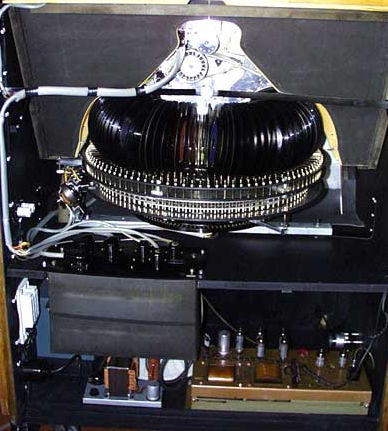
In
1957
and
the
advent
of
Telematic
200
player
and
then
the
Teleramic
200
the
amplifier
reverted
to
the
T31
this
also
was
full
of
bass,
and
used
the
same
bias
as
the
T30,
this
a
was
negative
bias
derived
from
one
half
of
the
HT
supply.
But
in
this
ranger
of
juke
boxes
as
the
year
went
by
the
amplifiers
changed
the
T32,
this
was
the
last
one
with
variable
treble
and
bass.
And
was
self
biased.
The
T33,
T34,
these
were
also
self
biased
and
they
all
sounded
different
having
switched
bass
and
treble,
and
they
had
different
tonal
changes
on
the
bass
and
treble
and
more
importantly
the
bias
was
self
biasing
that
is
to
say
the
cathodes
of
the
output
valves
were
returned
to
earth
via
a
resistor
I
don’t
know
whether
this
was
right
or
not,
but
it
saved
on
production
cost.
In
1959
we
got
the
last
of
these
machines
and
a
stereo
amplifier
there
were
two
amplifiers
for
this
particular
machine
but
the
circuit
was
the
same
the
smaller
one
I
think
was
a
T66
I
had
one
of
these
I
got
it
through
a
friend
that
went
to
the
sale
of
goods
when
the
works
closed.
The
bass
was
no
were
as
near
as
the
earlier
mono
amps, maybe because these were now 15 watts per channel stereo.
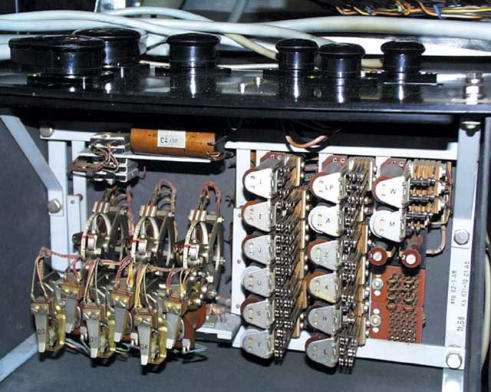
On
the
service
side
of
things,
the
first
thing
you
did
was
to
change
all
the
capacitors
of
the
black
Wyma
type,
you
would
see
cracked
and
split
coverings
so
you
replaced
the
lot
for
Mullard
capacitors,
the
other
thing
you
did
was
replace
the
decoupling
capacitors
to
the
output
valves.
Then
time
to
test
if
all
sounded
well
OK
if
not
find
out
why.
If
the
output
valves
were
running
correctly
you
would
see
in
dim
light
the
outputs
glowing
blue
this
signifies
that
the
valves
were
all
pulling
48
milli-amps
and
running
on
the
crest
of
the
valves
capacity,
but
this
only
happened
if
Mullard
valves
were
present,
we
used
what
we
could
get,
usually
the
cheaper
valves
“Brimar”
these
would
run
red
hot
on
the
anodes
but
performed
the
same
as the Mullards.
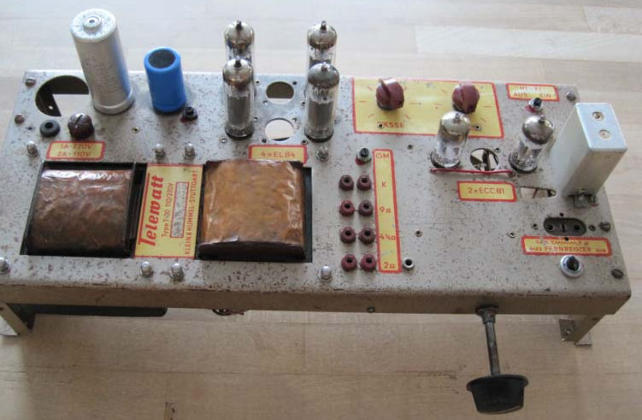
To
my
mind
as
I
only
worked
on
amplifier
service
for
these
machines
you
had
to
be
a
telephone
engineer,
why
because
they
had
their
own
Strowger
exchange
in
them,
it
seems
daft
but
when
you
look
at
the
system
you
used
a
dial
to
select
your
record
and
it
had
to
dial
at
a
determined
rate
of
10
pulses
a
second
if
it
was
more
or
less
you
did
not
get
anything
at
all
so
timing
of
the
pulses
were
imperative.
So
if
you
know
about
phones
or
you
know
an
old
fashioned
telephone
engineer,
he
would
understand
and
be
able
to
fix
them
we
had
three
of
these
engineers
in
the
factory
and
bloody
good
they
were
too,
Modern
telephones
today
operate
differently
and
use
dial
tones
(DTMF)
the
new
engineers
might
not
have
the
knowhow
to
fix
this
old
style
of
control.
To
select
the
record
number
you
used
a
telephone
dial,
these
were
manufactured
by
A.T.&
T
American
dials
but
made
in
Germany,
and
the
speed
was
corrected
by
the
bob
weights.
Also
the
relay
contacts
only
need
cleaning
lightly
do
not
use
a
file
you
will
destroy
the
contact
and
timing,
if
you
have
to
clean,
always
use
a
chemical
cleaner
spray.
The
engineers
that
serviced
these
machine
did
it
methodically
they
never
got
one
that
came
back
to
them.
These
engineers
were
Erick Pass, and Peter Cain.
These
machines
were
returned
from
sites
in
the
early
60s
and
were
stacking
up
the
workshop
from
1966
or
thereabouts,
and
we
could
do
nothing
with
them.
The
punters
did
not
want
them
because
they
looked
too
old
and
Ditchburn
did
not
want
to
scrap
them
because
they
were
still
far
too
good
to
scrap.
Geoffrey
Norman
Ditchburn
loved
these
machines.
They
were
the
first
he
imported
from
Germany
when
the
trade
embargo
was
lifted
and
they
were
the
only
machines
that
never
needed
more
than
a
new
stylus
every
six
months
and
they
owed
him
nothing.
But
scrapping
was
out
of
the
question
so
he
asked
cabinet
making
companies
for
designs
for
a
new
cabinet
to
give
them
a
new
lease
of
life
and
make
them
look
more
like
the
modern
day
Wurlitzer’s.
Of
the
three
designs
offered
he
chose
one
of
which
was
modern
and
he
set
about
producing
the
first
ten
cabinets
in
1968,
they
were
an
immediate
success.
We
had
hit
the
right
design
at
the
right time so the old machines were put in new cabinets.
You
may
or
may
not
agree
but
it
did
give
an
excellent
mechanism
a
new
lease
of
life
and
made
good
commercial
sense,
they
were
offered
for
sale
and
quite
a
few
were
sold
outright
and
others
went
for
hire,
not
all
the
original
cabinets
were
scrapped
though
until
we
sold
out
the
company
in
1972
when
Gainesmead
scrapped
all
Telematic’s
in
one
stroke.
They
were
the
first
machines
to
go,
but
at
least
we
did
give
them
another
four
years.
They
would
still
be
going
today,
so
if
you
have
one
of
these
machines
look
after
it,
be
it
in
its
original
cabinet
or
in
a
Ditchburn
cabinet
they
will
go
on
for
ever.
I
believe
the
Telematic’s
were
the
best
jukebox
ever
produced
bar
none
especially
with
the
T31
or
T32
amplifier,
they
were
ultra
reliable
and
if
not
messed
with
they
would
go
on
forever.
We
only
had
one
engineer
that
looked
after
the
selectors
of
these
machines,
an
ex
post
office
engineer
and
he
looked
after
the
Telematic
from
import
in
1957
to
the
scrapping
in 1972, by Gainesmead.
Ditchburn / Tonomat Machines import figures
1955/1956 Telemat 100 selection approximately 50 machines imported
1957 Telemat Teleramic 200 selection approximately 150 machines imported
1959 Panoramic 200 selection approximately 100 machines imported
1960 Teleramic 200 selection approximately 50 machines imported
An approximate total of 350 Tonomat machines were imported to the UK between 1955 and 1960
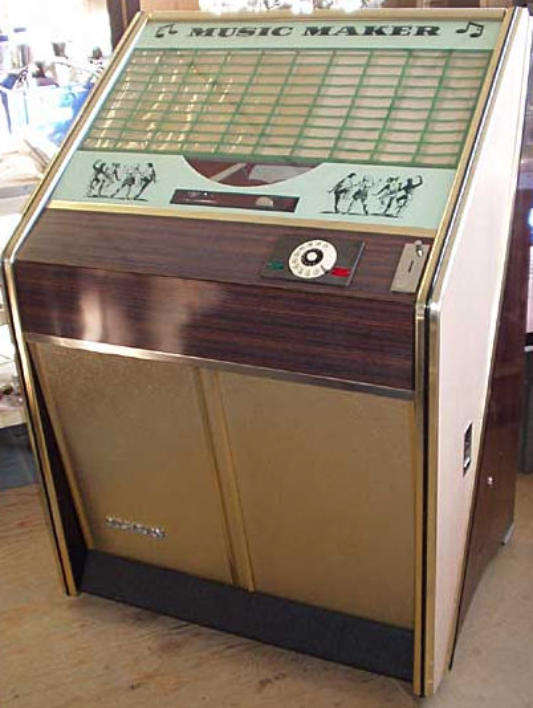
1948 to 1950
At
the
end
of
the
40s,
two
friends
from
the
area
around
Offenbach
/
Main
came
together
after
surviving
the
war,
the
technician
N.A.
and
the
merchant,
with
a
good
technical
knack,
W.T.
The
two
twenty-something
year
old
guys
first
develop
a
turntable
and
leave
this
patent.
Unfortunately,
the
two
have
to
drop
this
matter
after
about
two
and
a
half
years.
The
initially
good
sales
prices
of
the
devices
fall
off
rapidly
and
make
it
impossible
to
guarantee
the
livelihood.
At
the
end
of
1950
W.T.
and
N.A.
After
a
long
conversation,
continue
to
work
together.
Here
comes
the
idea
to
deal
with
development
and
construction
of
the
first
German
jukeboxes.
Back
then,
only
American
jukeboxes
were
available
in
local
restaurants,
whose
purchase
prices
were
sinfully
expensive
and
almost
un
affordable.
In
the
spacious
mansard
of
the
residential
building
of
W.T.
in
Offenbach
the
first
prototype
of
a
jukebox
is
constructed
and
built
after
work
and
on
weekends until late into the night.
1952
In
the
spring
of
1952,
the
30-year-old
precision
mechanic
A.D.
from
Frankfurt
to
the
two-man
troupe.
He
tackles
the
production
of
the
mechanical
parts
for
the
boxes.
In
the
late
autumn
of
1952,
the
first
halfway
finished
jukebox
is
ready.
The
mechanics
are
fitted
in
a
simple wooden case (manufactured in a joinery). The name of this jukebox is "Tonomat V 102".
1953
The
device
is
patented
and
presented
for
the
first
time
on
10.2.1953
in
an
Offenbach
city
cafe.
This
is
well
received
by
some
young
folk
but
above
all
in
the
media.
At
the
end
of
May
1953
it
is
decided
to
start
producing
the
boxes
independently.
The
Tonomat
V
102
is
being
revised.
The
joinery
A.P.
in
Offenbach.
The
steady
increase
in
pit
production
and
the
associated
increase
in
staff
are
leading
to
several
relocations
to
larger
and
larger
commercial
premises
in
the
surrounding
area
and
in
the
city
of
Offenbach.
At
the
beginning
of
August
the
first
boxes
go
on
sale
-
Unit
price
DM
3000,
-.
In
the
second
half
of
March
you
register
at
the
District
Court
Offenbach
trade.
In
November 1953, mechanical engineer E.B. the leadership in the small company.
1954
A
first
boxing
service
for
the
region
of
Munich
and
surrounding
areas
is
established.
It
is
headed
by
a
Bavarian
mechanic.
Meanwhile,
they
develop
a
second
box
and
baptize
them
on
the
name
"Telematic
100",
which
can
play
50
records,
which
will
later
be
increased
to
100
pieces
with
the
"Telematic
200".
The
Tonomat
boxes
will
be
presented
successfully
at
some
fairs
Sales
figures
continue
to
increase
after-sales
service
technicians
are
hired
and
trained
in-house
for
their
service.
In
the
summer
of
1955,
a
general
agency
is
opened
in
Vienna. Furthermore, they also sells boxes from an English manufacturer ( Ditchburn) , with whom one has made the best contacts.
1956-1957
When
the
city
of
Offenbach
advertises
a
new
business
park
and
offers
cheap
land
there,
the
plant
managers
access
and
buy
the
site.
There
one
builds
a
large
company
complex
with
administration,
sales,
assembly,
etc.,
which
is
inaugurated
on
30.11.1957
solemnly.
The
company
name
"Tonomat"
now
lights
up
in
large
lettering
above
the
main
entrance.
Soon
there
will
be
a
first
boxing
order
of
1000
pieces from England (Ditchburn). In Munich, the small customer service becomes a larger agency of the company
1959
At
the
Frankfurt
Spring
Fair
the
latest
development
of
Tonomat
will
be
presented,
the
"Panoramic
200",
a
large
box
for
a
small
price,
but
with
a
double
capacity
of
200
records.
In
the
same
year,
the
General
Administration
of
the
American
box
manufacturer
"Wurlitzer",
the
company
Husemann
collapses
in
Cologne
-
a
first
warning!
In
April
1959,
the
company
Tonomat
surprisingly
receives
a
visit
from
two
senior
managers
of
the
American
companies
"Canteen"
and
AMI
(American
Musical
Instruments).
Half
a
year
earlier,
these
companies
had
joined
forces.
Apart
from
boxes,
these
companies
also
built
beverage
and
food
vending
machines.
This
large
American
company
also
wanted
to
establish
itself
in
Europe
and
had
the
plan
to
buy
the
company
"Tonomat"
for
it.
The
Tonomat
management
was
initially
very
skeptical
about
this
request.
But
the
Americans
did
not
give
up.
After
long
and
tough
negotiations,
the
final
decision
was
made
in
favor
of
the
Americans.
At
the
end
of
August
1959
the
company
"Tonomat"
changed
ownership
for
four
million
DM
and
from
now
on
takes over the name "Canteen Automatenbau GmbH".
The
three
founders
continue
to
be
managing
directors.
The
focus
of
production
is
now
more
and
more
on
the
production
of
beverage
and
food
vending
machines.
Cabin
assembly
is
becoming
more
and
more
of
a
byproduct.
Nevertheless,
a
new
box
type
is
released,
the
"Teleramic 200".
1960 ff
The
takeover
by
"Canteen"
soon
turns
out
to
be
a
mistake.
The
Americans
demand
too
fast
and
highly
productive
production
of
machines
and
boxes
that
can
not
be
implemented
in
Germany.
The
market
share
is
reduced
to
almost
40%.
The
three
German
company founders are therefore detaching themselves from Canteen and taking other career paths.
In
1963
the
production
of
jukeboxes
is
completely
discontinued.
The
dream
of
the
three
company
founders
was
extinguished
and
a
short, but quite successful jukebox company came to an end - unfortunately!
The History of Tonomat Jukeboxes 1948 to 1963
Translated from German, courtesy of www.jukebox-world.de

